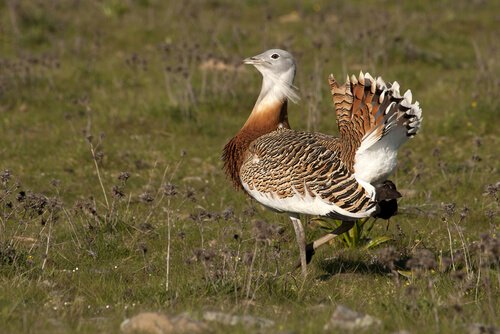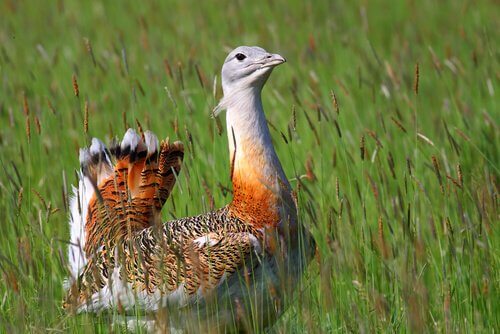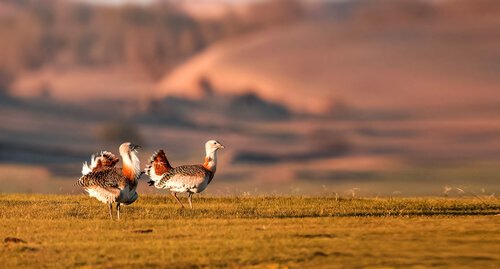The Fascinating Mating Rituals of the Great Bustard

In popular terms, the great bustard family of birds is composed of different species of flying birds that look particularly robust, and abound in the Iberian peninsula.
Recently, bustards have re-captured the attention of the scientific community because of their strange mating rituals.
Scientists have discovered that male great bustards self-medicate with small doses of a toxic substance in order to attract females. This is one of the many curiosities about the great bustard that we’d like to tell you about in this article.
Curiosities and interesting facts about the great bustard
Great bustards are the heaviest flying birds
To this day, the great bustard is the heaviest flying bird known to experts. It’s also the most robust species to inhabit Europe.
It’s also worth highlighting that great bustards have very obvious sexual dimorphism, and you can easily differentiate the males from the females. In some species, as in the common bustard, the male can be three to four times the size of the female.
These birds also differ notably in their body weight and the robustness of their appearance. While females usually do not exceed 13 pounds, males can weigh up to 32 pounds in adulthood.
Spain is great bustard “paradise”
Although they can be seen throughout Europe, it is estimated that about half of the total population of bustards lives in Spain. The advancement of agriculture and its easy adaptation to human habitats have helped it spread.

At present, great bustards are concentrated on the cereal plantations in Spain, mainly in the South and center of the Iberian peninsula.
Because of that, it’s common to see them flying through the skies in the Iberian Peninsula, especially when in the plains. However, some species are at risk of extinction because of hunting.
Their silence defines them more than their song
Unlike most birds that are identified by their songs, the great bustard is characteristically silent. Their behavior is discrete and silent, even during the mating season. For that reason, amateurs and researchers call them the “silent birds”.
In addition, great bustards get scared easily, and are always on the alert. That way, they can quickly identify any predators and escape rapidly. Because of that, it’s difficult to approach a great bustard in the wild, because they will probably fly away as soon as they hear any noise.
Male great bustards self-medicate to attract females
Male great bustards ingest small amounts of two species of beetles that contain a toxic substance called cantharidin. However, their bodies have developed a certain tolerance that allows them to consume it in small amounts and benefit from its medicinal properties.
According to researchers, males do this for two reasons. They ingest a potentially toxic substance not only in order to mate, but also to eliminate parasites in their bodies and fight infections.

In fact, it’s very likely that these two reasons are related. When a male has no parasites and diseases, he looks better and is in better health. That increases his chances of attracting females.
Females also usually consume beetles, but only males select the two species with high cantharidin content. This peculiar way of attracting mates can be seen in very few species of the animal kingdom. For this reason, great bustards have re-awakened the curiosity of the scientific community.
Their exposed rears are related to their self-medication
Great bustards have exposed rears, and males have white plumage around their rears. Experts point out that they probably have this feature in order to attract females. How is that possible?
When a male approaches, the female does a thorough inspection of his rear before accepting his advances. It does this to make sure he is in good health and has no parasites, so it can choose a healthy, vigorous partner.
Therefore, it’s possible that its tolerance for cantharidin is also related to the morphological aspects of the male great bustard. With its exposed white rear, a male can “brag” to females about his good health and resistance, so that they will choose him.
